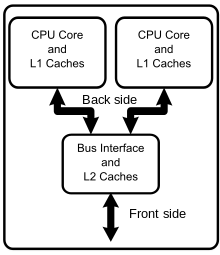
Back مسرى أمامي Arabic Системна шина Bulgarian Prednja sabirnica BS Front side bus Catalan Front Side Bus Czech Front Side Bus Danish Front Side Bus German Bus frontal Spanish Esisiin Estonian گذرگاه سمت-جلو Persian

The front-side bus (FSB) is a computer communication interface (bus) that was often used in Intel-chip-based computers during the 1990s and 2000s. The EV6 bus served the same function for competing AMD CPUs. Both typically carry data between the central processing unit (CPU) and a memory controller hub, known as the northbridge.[1]
Depending on the implementation, some computers may also have a back-side bus that connects the CPU to the cache. This bus and the cache connected to it are faster than accessing the system memory (or RAM) via the front-side bus. The speed of the front side bus is often used as an important measure of the performance of a computer.
The original front-side bus architecture has been replaced by HyperTransport, Intel QuickPath Interconnect, Direct Media Interface and nowadays by Intel Ultra Path Interconnect in modern Intel CPUs for personal computers.
- ^ Scott Mueller (2003). Upgrading and repairing PCs (15th ed.). Que Publishing. p. 314. ISBN 978-0-7897-2974-3.
© MMXXIII Rich X Search. We shall prevail. All rights reserved. Rich X Search